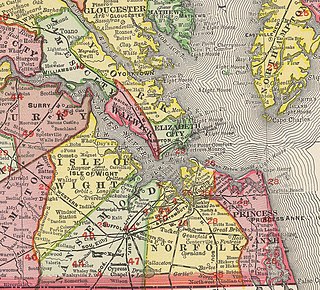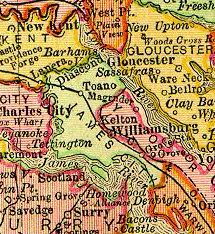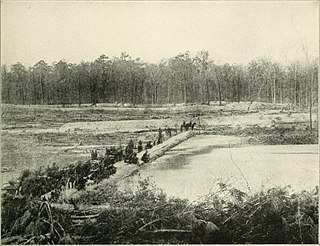
Skiffe's Creek is located in James City County and the independent city of Newport News in the Virginia Peninsula area of the Hampton Roads region of southeastern Virginia in the United States. It is a tributary of the James River.

Skiffe's Creek is located in James City County and the independent city of Newport News in the Virginia Peninsula area of the Hampton Roads region of southeastern Virginia in the United States. It is a tributary of the James River.
In the early 17th century, Skiffe's Creek bordered Martin's Hundred, a proprietary settlement dating to 1618 in the British Colony of Virginia. The creek formed one of the borders between James City Shire and Warwick Shire when they were formed in 1634 by the House of Burgesses as directed by King Charles I. They were two of the eight original shires of Virginia.
For over 300 years, Skiffe's Creek was part of the boundary between James City County and Warwick County. Early speaker of the House of Burgesses Thomas Harwood established the Queen Hith plantation on both sides of Skiffe's Creek, and his descendants for generations kept it as their family seat, until great-great-grandson William Harwood finished Endview Plantation in 1769, and moved his family there. Upon the consolidation of Warwick County into the city of Newport News in 1958, both plantations became part of the City, which acquiredthe Endview plantation in 1995 and how operates it and two other house museums. The creek continues to be the dividing line between the two political subdivisions of Virginia, with the precise address of Queen Hith plantation archeological site in the Oakland farms neighborhood now withheld.
In 1881, Skiffe's Creek was bridged by a trestle of the new Peninsula Subdivision. Collis P. Huntington led the development of the Chesapeake and Ohio Railway through the new Church Hill Tunnel and down the Virginia Peninsula through Williamsburg where it finally reached coal piers located on the harbor Hampton Roads, the East Coast of the United States' largest ice-free port. During the ten years from 1878 to 1888, C&O's coal resources began to be developed and shipped eastward. Coal became a staple of the C&O's business at that time and still does over 125 years later under successor CSX Transportation.
The Lee Hall depot, two miles east of the Skiffe's Creek crossing, was built in 1881-82, and was later expanded. The station served tens of thousands of soldiers based at Fort Eustis during World War I and World War II.
Skiffe's Creek Reservoir is a portion of the Newport News Waterworks, a regional water provider, owned and operated by the City of Newport News that serves over 400,000 people in the cities of Hampton, Newport News, Poquoson, and portions of York and James City County. [1]
The regional water system, which initially included an impingement of the Warwick River in western Warwick County, was begun as a project of Collis P. Huntington as part of the development of the lower peninsula with the Chesapeake and Ohio Railway, the coal piers on the harbor of Hampton Roads, and a massive shipyard which were the major sources of industrial growth which helped establish Newport News as an independent city in 1896.
In the early 20th century, Skiffe's Creek was bridged by U.S. Route 60. Today, most through traffic uses the Interstate 64 or State Route 143. Route 60 primarily links local traffic between the Grove community of southeastern James City County and the Lee Hall community of Newport News. Both communities are attempting to retain their rural appearance even as their respective localities are both being developed. Additionally, a small portion of the expansive Naval Weapons Station Yorktown is in the Skiffe's Creek watershed. [2]
In the late 20th century, the rural two story frame depot at Lee Hall was saved from demolition by rail enthusiast and rail preservationists. In June 2007, a CSX hopper train derailed at the Skiffe's Creek Trestle, with no injuries.

Newport News Shipbuilding (NNS), a division of Huntington Ingalls Industries, is the largest industrial employer in Virginia, and sole designer, builder, and refueler of aircraft carriers and one of two providers of submarines for the United States Navy. Founded as the Chesapeake Dry Dock and Construction Co. in 1886, Newport News Shipbuilding has built more than 800 ships, including both naval and commercial ships. Located in the city of Newport News, its facilities span more than 550 acres (2.2 km2), strategically positioned in one of the great harbors of the East Coast.

Newport News is an independent city in Virginia, United States. At the 2020 census, the population was 186,247. Located in the Hampton Roads region, it is the fifth-most populous city in Virginia and 140th-most populous city in the United States.

James City County is a county located in the Commonwealth of Virginia. As of the 2020 census, the population was 78,254. Although politically separate from the county, the county seat is the adjacent independent city of Williamsburg.

The James River is a river in Virginia that begins in the Appalachian Mountains and flows 348 miles (560 km) to the Chesapeake Bay. The river length extends to 444 miles (715 km) if the Jackson River is included, the longer of its two headwaters. It is the longest river in Virginia. Jamestown and Williamsburg, Virginia's first colonial capitals, and Richmond, Virginia's current capital, lie on the James River.

The Virginia Peninsula is a peninsula in southeast Virginia, bounded by the York River, James River, Hampton Roads and Chesapeake Bay. It is sometimes known as the Lower Peninsula to distinguish it from two other peninsulas to the north, the Middle Peninsula and the Northern Neck.

Collis Potter Huntington was an American industrialist and railway magnate. He was one of the Big Four of western railroading who invested in Theodore Judah's idea to build the Central Pacific Railroad as part of the first U.S. transcontinental railroad. Huntington helped lead and develop other major interstate lines, such as the Southern Pacific Railroad and the Chesapeake & Ohio Railway (C&O), which he was recruited to help complete. The C&O, completed in 1873, fulfilled a long-held dream of Virginians of a rail link from the James River at Richmond to the Ohio River Valley. The new railroad facilities adjacent to the river there resulted in expansion of the former small town of Guyandotte, West Virginia into part of a new city which was named Huntington in his honor.

The Chesapeake and Ohio Railway was a Class I railroad formed in 1869 in Virginia from several smaller Virginia railroads begun in the 19th century. Led by industrialist Collis P. Huntington, it reached from Virginia's capital city of Richmond to the Ohio River by 1873, where the railroad town of Huntington, West Virginia, was named for him.

Warwick County was a county in Southeast Virginia that was created from Warwick River Shire, one of eight created in the Virginia Colony in 1634. It became the City of Newport News on July 16, 1952. Located on the Virginia Peninsula on the northern bank of the James River between Hampton Roads and Jamestown, the area consisted primarily of farms and small unincorporated villages until the arrival of the Peninsula Extension of the Chesapeake and Ohio Railway in 1881 and development led by industrialist Collis P. Huntington.

Williams Carter Wickham was a Virginia lawyer and politician. A plantation owner who served in both houses of the Virginia General Assembly, Wickham also became a delegate to the Virginia Secession Convention of 1861, where he voted against secession, but after fellow delegates and voters approved secession, he joined the Confederate States Army and rose to the rank of cavalry general, then became a Confederate States Congressman near the end of the American Civil War. Later, Wickham became a Republican and helped rebuild Virginia's infrastructure after gaining control of the heavily damaged Virginia Central Railroad, which he repaired and helped merge into the Chesapeake and Ohio Railway company. Cooperating with financier Collis Huntington, Wickham developed coal resources and the Newport News Shipyard. He was also again elected to the Virginia Senate. His son Henry T. Wickham also became a lawyer and would work with his father and eventually twice become the speaker pro tempore of the Virginia Senate.

Grove is an unincorporated community in the southeastern portion of James City County in the Virginia Peninsula subregion of Virginia in the United States. It is located in the center of the Historic Triangle of Colonial Virginia, communities linked by the Colonial Parkway. This area is one of the busiest tourist destinations in the world.

Lee Hall is an unincorporated town located in the extreme western portion of the independent city of Newport News in the Commonwealth of Virginia in the United States.

Endview Plantation is an 18th-century plantation which is located on Virginia State Route 238 in the Lee Hall community in the northwestern area of the independent city of Newport News, Virginia.<

The Warwick River is a 14.4-mile-long (23.2 km) tidal estuary which empties into the James River a few miles from Hampton Roads at the southern end of Chesapeake Bay in southeast Virginia in the United States. Originating in York County near the northern side a few miles west of Yorktown, it flows south across the Virginia Peninsula and is almost entirely located in the independent city of Newport News.

U.S. Route 60 (US 60) in the Commonwealth of Virginia runs 303 miles (488 km) west to east through the central part of the state, generally close to and paralleling the Interstate 64 corridor, except for the crossing of the Blue Ridge Mountains, and in the South Hampton Roads area.

Newport News has a long history dating back to the days of Jamestown, Virginia. The area which is now the city of Newport News has existed under different names and forms including Elizabeth Cittie, Warwick River Shire, Warwick County, Virginia, Warwick City, and the current independent city of Newport News.
James Clyde Morris was a civic leader in the Hampton Roads region of southeastern Virginia. His career spanned 32 years of public service.

The Peninsula Extension which created the Peninsula Subdivision of the Chesapeake and Ohio Railway (C&O) was the new railroad line on the Virginia Peninsula from Richmond to southeastern Warwick County. Its principal purpose was to provide an important new pathway for coal mined in West Virginia to reach the harbor of Hampton Roads for coastal and export shipping on collier ships.
Captain Thomas Harwood was a Virginia soldier, landowner and politician. He founded a family which like him for generations often represented the area now known as Newport News, but which in his day was known as Mulberry Island, and later Warwick River and still later Warwick County. Despite coming into conflict with royal governor Sir John Harvey in 1635, and a gap in legislative service, Harwood became the 5th speaker of the House of Burgesses.
The following is a timeline of the history of the city of Newport News, Virginia, United States.